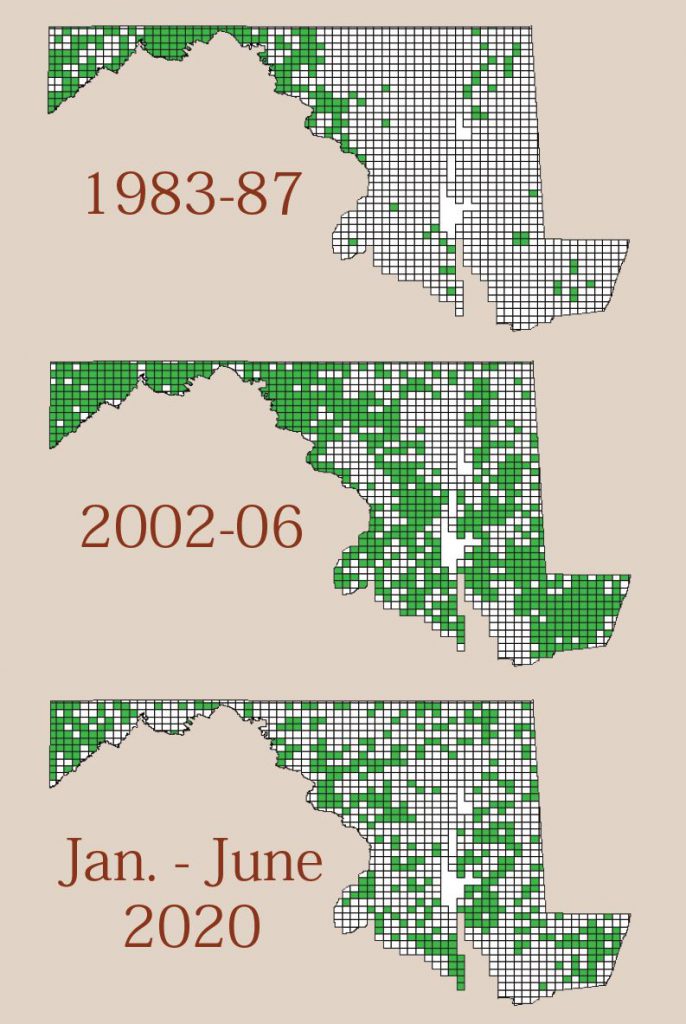Bird Search: Third Breeding Bird Atlas Effort is Underway
At some point, you’ve probably found evidence of a breeding bird. Maybe you were doing some yard work and came across a robin’s nest, or maybe you spooked a turkey and her chicks while scouting for whitetails, or maybe you were fishing and found a heron colony. Finds like these make each excursion outdoors an adventure with unpredictable rewards, but these experiences can also yield valuable data that will help manage and conserve Maryland’s ecosystems.
The Maryland & DC Breeding Bird Atlas 3 is a five-year project documenting the distribution, abundance, and timing of the region’s breeding birds. Observations are collected almost entirely by volunteers and are submitted to an online database. Running from 2020 to 2024, this effort is the third time a breeding bird atlas has been done in Maryland and D.C; each atlas is separated by about 20 years. The results of each atlas can be compared to earlier results to show how populations have changed over time—invaluable data for anyone managing wildlife and their habitats.
For example, northern bobwhites have been experiencing a decline in Maryland for the past few decades, as folks familiar with the species know well. This change is clearly illustrated when the data from each Atlas are compared.

Northern bobwhite distribution data from the first two MD-DC breeding bird atlases and data from the first year of the third atlas.
To collect their data, observers get into every corner of the state during the Atlas project. Maryland and D.C. are divided into approximately 1,300 blocks, each 9 square miles. Observers search each block for as many breeding birds as they can find, then report those species for that location. To determine whether a bird is breeding, observers use breeding codes. Each breeding code is a description of a behavior that suggests or confirms breeding, such as singing (code S), a male and female pair (P), nest building (NB), or, best of all, a nest with eggs or chicks (NE or NY).
Anyone can participate in the Atlas, even if it is just to submit a single observation. All you need to be able to do is identify the species you observed, select the appropriate breeding code, and submit it to the online database. Knowing the date and location of your observation, and how many birds were present, is also important. The equipment necessary for atlasing is fairly minimal, including binoculars, a bird identification guide, and a smartphone—using the eBird app makes recording observations a breeze.
If you own private land, observations from your property are especially valuable. For example, landowners’ reports are one of the best ways to track barn owl populations, since landowners tend to be intimately familiar with their property and the wildlife using it, even when that wildlife is difficult to detect. If you are a landowner who hasn’t mastered bird identification yet, but you would like to know what birds are breeding on your property, you can contact Atlas Coordinator Gabriel Foley at mddcbba3@mdbirds.org. He can arrange for a local atlaser to visit your land and provide you with a list of the birds nesting there. The average number of species found in each block is an astonishing 75 species, so you may be surprised at just how many birds nest in your back forty.

Wild turkey distribution data from the first two MD-DC breeding bird atlases and data from the first year of the third atlas.
Anyone who spends time outdoors is bound to find breeding evidence sooner or later. If you hunt turkeys, you are particularly well-situated to provide data to the Atlas. During the spring turkey season, male turkeys are constantly displaying to females—excellent evidence of breeding. Reporting where you have seen turkeys displaying can help ensure the Atlas data are as complete as possible to provide better information for managing state turkey populations.
You can explore the data that have been submitted to the Atlas since January 2020 at ebird.org/atlasmddc/explore—just type in the name of a bird to start. You can find more details about atlasing methods in the online Atlaser Handbook. Reach out to the coordinator if you have questions not answered there. You can also find the Atlas on social media at @mddcbba3.
Atlasing can teach you more about bird identification and behavior, it can lead you to new areas you might not otherwise visit, and it can be surprisingly exciting to add new species to your favorite location’s list of breeding birds. It is an exceptionally rewarding experience, and your observations will help ensure we have healthy, functioning ecosystems in Maryland for years to come.
dnr.maryland.gov/wildlife
Gabriel Foley is the Maryland-D.C. Breeding Bird Atlas coordinator. Article appears in Vol. 23, No. 3 of the Maryland Natural Resource magazine, fall 2020.



 1-888-373-7888
1-888-373-7888 233733
233733